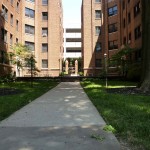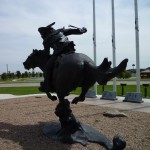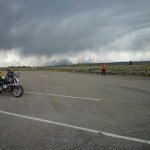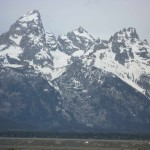In the mid 1980s I worked at The Kansas City Star as editor of the Sunday magazine. Though I had lived and worked in the South – Knoxville, Miami, Charlotte, Louisville, Dallas – Kansas City was my first extensive experience in the Midwest. I worked with talented people and we produced some excellent work.
One of the more memorable stories we published was a thoughtful essay by Don Hoffmann, one of the newspaper’s arts writers. The coverline of the story was designed to grab the attention of the reader, and it did: Why Is Kansas City So Dull?
Hoffmann’s premise was simple – during the city’s founding years, it was a starting point, the jump-off place for those seeking their fortune to the west, adventurers heading out on the long journey to the Pacific Northwest, California, or the Southwest. Among the wagon-train trails that began in Kansas City were the Oregon, the Overland, and the Santa Fe. Those who settled in Kansas City had either tired of the journey west to an uncertain future or saw opportunity in service to those heading onto the Great Plains and what lay beyond.
Frequently, partly because of my own ignorance of, and interest in, that part of the country, our stories looked west, too. Jim Kindall re-traced the Pony Express routes. Brian Burns took the train west to Dodge City for an article that echoed that town’s storied past. Kindall explored Kansas’ Flint Hills, where nature created the grasslands that became fattening fodder for cattle driven north from Texas before they were shipped to the slaughterhouses of Omaha and Chicago.
But I didn’t explore much of the country myself, and after a year and a half, I moved to Atlanta.
So this past spring I decided it was time to take a look at the northwestern part of the U.S. – by automobile. I have friends in Boise, Idaho, in Bellingham, Washington, and in Santa Fe, New Mexico, so my plan included those stops. I would take the northern route to Vancouver, British Columbia, south to San Francisco, east across the Mojave, on to Santa Fe, then a dash across the Texas panhandle, Oklahoma, Arkansas and home. (When I lived in Dallas I had explored west Texas, New Mexico, and Arizona, so those areas were not on my to-see list.)
The route I took to Kansas City was via Nashville, southwestern Kentucky, southern Illinois to St. Louis, then across Missouri to Kansas City. It was uneventful, though the river casinos were new from my last trek through those areas. At St. Charles, just west of St. Louis, a billboard-sized Debbie Reynolds invited me to a casino on the Missouri River.
The casinos and their headliners would become a point of interest; as I got into the western states, Indian-reservation gambling would dominate billboards. Upcoming headliners included Gary Puckett & the Union Gap, Anita Baker, Kenny Rogers, Slash, Rod Stewart – quite a lineup of old rockers.
In Kansas City, I checked out my former residence in an apartment building on the Plaza, the city’s famous and still-hopping residential, dining and shopping complex. Built in the 1920s, the Plaza is touted as the nation’s first planned shopping mall. The apartment building, the Cezanne, was still there.
Because of its proximity to a host of entertainment, it was one of the best places I ever lived. Besides convenience, the amenities of my first-floor apartment included spacious rooms and lots of storage. My next-door neighbors provided a regular Sunday-morning wakeup – with noisy sex.
Most of the restaurants and many of the retail establishments had changed – there was no sign of the sports bar I had frequented, a raucous joint that had been owned by former Royal Lou Piniella. But I found a substitute and had a quieter – and healthier – lunch than I would have had at my old haunt.
Another stop was Andre’s Confiseire Suisse, where I had been a regular customer. I loaded up with several favorites, enough to get me to the West Coast, and to my relief found that the elegant sweetshop is still in the family of Andre Boller, the native of Basel who founded the business with his wife Elsbeth in 1955.
After realizing that I had enough daylight to make it halfway across Nebraska, I headed northwest, past St. Joseph and on into Iowa. (I hadn’t noticed it before, but Missourians seemed to favor Catholic saints when it came to naming settlements.) I only caught a corner of Iowa before crossing the Missouri River into Nebraska. Deciding that Grand Island would work as the first overnight stop, I skirted Lincoln, though I did not escape the ubiquitous Cornhusker fanaticism.
But first I was startled from my interstate reverie by something looming over the highway in the distance. When I was close enough, I beheld the Great Platte River Road Archway, which spans Interstate 80. The city fathers at Kearney had come up with a way to bring their town to the attention of interstate travelers. Adorned with fanciful metal sculptures of winged horses at each end, it houses “two stories of interactive exhibitory.” That promise, as fanciful as the sculptures, was not enough – I kept driving.
Grand Island wasn’t memorable, except for the name. In a part of the country where any middling stream, no matter how small, is tagged as a “river,” an island that is truly “grand” seems out of the question.
Early the next morning, back on Interstate 80, I passed a motorcyclist being ticketed by a state trooper. I could not miss the biker; he was wearing neon-green leather to match his crotch rocket. A few miles on down the highway, he passed me. I was cruising at about 65 miles per hour, more interested in good mileage then making time, so the biker was not much above the speed limit when he went by.
My car is a hybrid Camry, with a gauge that keeps me informed as to my mileage. Usually, on the highway I get 43 or 44 miles per gallon, but I noticed that I was only getting about 37 or 38. When I next stopped for gas, I discovered why. The wind nearly knocked me down when I exited the car – I was driving into a formidable headwind, a phenomenon that would be constant through much of Nebraska, Wyoming and Idaho.
At the stop, about 50 miles east of where Interstate 76 split south for Denver, there was a large map on the wall. As I stood there looking at it, the biker walked up. “Can you show me where we are?” he wanted to know. I showed him, and then asked if that was him I had seen being ticketed several miles back. “Yeah, that was me,” he said. “He clocked me at 93 miles per hour.”
Then he said that he had left Lansing, Michigan, the morning before and had also gotten a speeding ticket in Illinois. After studying the map, he said he was hoping to make Las Vegas, via Denver, by nightfall. He was headed to a motorcycle show. With a little measuring we determined that he was more than a thousand miles away, and I pointed out that he was going to cross the Rockies. He added that he guessed he would have to slow down.
“Have you ever driven that way at night?” he wanted to know. I told him that it had been years ago, and, though he would be on an interstate, he would still be going through the mountains and that he would be crazy to push it. He looked resigned.
Outside, I noticed that he was riding a Kawasaki Ninja, frighteningly fast. I hope he made it.
I drove on to Sidney before stopping for lunch. Sidney, about 70 miles east of the Wyoming state line, is on the Pony Express route and on the old gold-rush trail to Deadwood as well.
There is a monument to the former, and much mention of the latter in the town’s commercial literature.
At the Buffalo Point Restaurant & Bar, my waitress was a leggy blonde, a real looker in bluejeans and cowboy boots. She told me her name was Dakota. I thought I was in a Bob Dylan song.
On to Cheyenne, then north on Interstate 25 toward Yellowstone, where I planned to spend some time. More winds across Wyoming, but not much of interest – smelly cattle feedlots and sparse grasslands. I did notice that the group responsible for keeping one section of the highway spruced was a local nudist club. And I spotted a couple of working cowboys driving a lone steer up a draw. They were riding ATVs.
In Casper, I spent the night in a motel a couple of blocks from the Dick Cheney Federal Building. The next morning I decided to leave the interstate and head west on U.S. 26, after being assured that it was a good road though there would be highway construction up in the mountains. A few miles out of town, I saw the first pronghorn antelope of the journey. Then it was mile after mile of pronghorn antelope as I drove through the Wind River Indian Reservation, shared by Shoshone and Arapaho.
At Crowheart Butte, site of a decisive battle between Crow Indians and a confederation of Shoshone and Bannock tribes, I stopped to stretch my legs and read up on the butte, which was surprisingly pronghorn-free. Then on into Dubois and a stop for gas. Next to me at the pumps was a booted cowboy pulling a horse trailer with two mounts aboard, both saddled and ready to ride. He was talking on his cellphone.
The highway started climbing outside Dubois; I was in the mountains. True to my advisor in Casper, I was soon stopped by construction. And it was a serious re-do of the road: one lane only, with traffic being led around massive earthmovers by a pilot truck. We took our turn waiting, then followed the truck through gravel and mud, for a couple of miles or so, before we were back on pavement and heading toward the western slope.
At Togwotee Pass, I got my first look at the Tetons, snow-covered and majestic in an area dotted with spectacular peaks. As I drove down toward Moran and Jackson, the Tetons provided a looming marker.
Then a quick-moving storm dropped over the top of the mountains and into the valley, moving east toward Togwotee and in my direction. At a pull-out I stopped for photos, joining a lone motorcyclist already there with his camera.
There was lightening just ahead of the cloud front and we both were trying to capture that ever-elusive element. The storm was moving a bit to our left – it looked as if we would be spared its brunt. Finally we gave up, though the biker said he got one image of lightening. I warned him about the upcoming construction over the mountains (he was heading east) and continued on down toward Jackson. At the next pull-out I stopped for more photos as the storm had left the air clear, the Tetons razor-sharp. As I turned back for my car, I noticed an incredible cloud formation, the back end of the storm, and got what will be my best photo of the trip.
Through the National Elk Reserve and into the town of Jackson, home to one of the West’s oldest and most famous ski resorts, Jackson Hole. The town square is dominated by arches built from antlers – and on the day I arrived, by a group of abortion protesters and law-enforcement officers insuring that the protest stayed peaceful. I found a room at the venerable Jackson Hole Lodge, facing the now bare slopes.
A stroll around the town revealed an appealing Old West ambiance, from the 1950s’ look of the Million Dollar Cowboy saloon to the luxurious Wort Hotel, with its bar inlaid with more than two thousand 1921 silver dollars. And there were those antler arches. This place could lead a younger person to ski bumdom. The desk clerk at the lodge later confirmed my impression, admitting that he had spent several years doing just that. “My little sister,” he added, “still spends most of her time on the slopes during the season.”
But there was no snow now, at least at the elevation of Jackson. But I found plenty when I re-traced my route and drove into Grand Tetons National Park and then Yellowstone.




